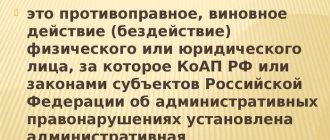1. A protocol on administrative detention is drawn up, which indicates the date and place of its preparation, the position, surname and initials of the person who compiled the protocol, information about the detained person, the time, place and reasons for the detention.
2. The protocol on administrative detention is signed by the official who compiled it and the detained person. If the detained person refuses to sign the protocol, a corresponding entry is made in the protocol on administrative detention. A copy of the protocol on administrative detention is given to the detained person at his request.
- Article 27.3. Administrative detention
- Article 27.5. Terms of administrative detention
Commentary to Art. 27.4 Code of Administrative Offenses
The commented article contains a requirement for the mandatory drawing up of a protocol on administrative detention and indicates what should be contained in it. Among the requirements for the protocol, you should pay attention to the following:
- when indicating the time of detention, it is necessary to indicate not the time of actual restriction of freedom, but the time of delivery of the person to the relevant authority or the time of his sobering up;
— the commented part requires a mandatory indication in the protocol of the motives for the arrest. In practice, instead of motives, protocols often indicate either the grounds for detention (suspicion of committing an administrative offense) or goals (the need to draw up a protocol on an administrative offense, execute a resolution in a case of an administrative offense, etc.). This is incorrect - the motive for detention should explain why the use of this coercive measure in this particular case was necessary. This understanding of the motive, in our opinion, follows from the indication of the exceptional nature of administrative detention (Part 1 of Article 27.3), which should be applied only in cases where there are other ways to ensure the correct and timely consideration of a case of an administrative offense or the execution of a decision in a case of administrative offense is impossible.
Deprivation of liberty without a protocol on administrative detention
The project of the Committee of Civil Initiatives “Open Police” continues a series of publications on the AG website dedicated to judicial acts related to the activities of law enforcement agencies in Russia and designed to protect the rights of citizens when interacting with the police.
This article will discuss the formalization of administrative detention and the importance of the corresponding protocol for ensuring the rights of persons suspected of committing offenses.
Norm Art. 5 of the Convention for the Protection of Human Rights and Fundamental Freedoms (hereinafter referred to as the European Convention) guarantees everyone the right to liberty and security of person. It requires respect for the principle of legality, in particular where the arrest is made in order to bring a person before the competent authority on reasonable suspicion of having committed an offence, or where there are reasonable grounds for believing that it is necessary to prevent the person from committing an offense or to prevent him from absconding after its completion.
The Code of the Russian Federation on Administrative Offenses (Article 27.1), as one of the measures to ensure proceedings in a case of an administrative offense, provides for administrative detention, which actually means deprivation of liberty, albeit of a short-term nature. Thus, the period of administrative detention should not exceed three hours, with the exception of certain cases - for example, if administrative arrest is provided as one of the measures of administrative punishment for an offense of which a citizen is suspected (Article 27.5 of the Code of Administrative Offenses of the Russian Federation). Considering that the original version of the Code of Administrative Offenses of the Russian Federation in 2002 included only fifteen offenses, the commission of which could entail punishment in the form of administrative arrest, and now their number has increased approximately fourfold, the risk of being detained for two days has also increased.
At the same time, it is a mistake to believe that the mere fact of suspecting a person of committing an offense automatically allows the police to detain a citizen and deprive him of his liberty even for three hours, much less for 48 hours - the provisions of the national law require law enforcement agencies to justify the need to take such a radical measure , and also explain what constitutes the exclusivity of a particular case within the meaning of Art. 27.3 Code of Administrative Offenses of the Russian Federation. Finally, to protect the rights of citizens, police officers are required to draw up a protocol on administrative detention, which includes, among other things, information about the time and place of detention, as well as its motives.
In other words, the protocol on administrative detention is the main procedural document, which acts as the main mechanism for protecting a person detained on suspicion of committing an administrative offense from arbitrary deprivation of liberty and, to some extent, from torture and ill-treatment. Therefore, the importance of preparing this procedural paper is difficult to overestimate.
In addition, in Art. 3.9 of the Code of Administrative Offenses of the Russian Federation establishes that the period of administrative detention is included in the period of administrative arrest, therefore, failure to draw up a protocol on administrative detention by police officers in practice makes it impossible to include the period of detention in the term of the sentence imposed by the court if the person is subsequently found guilty.
The European Court of Human Rights had to deal with a similar situation in the case “Denisenko v. Russia” (Decision dated February 14, 2021 on complaint No. 18322/05).
On July 15, 2004, at about two o'clock in the afternoon, Maxim Denisenko was arrested on suspicion of robbery and taken to the police station. Then the scenario developed according to a rather ordinary and already familiar pattern: for some reason, law enforcement officers also suspected Denisenko of an administrative offense in the form of petty hooliganism, which, in their opinion, made it possible to detain him for consideration of this offense. According to the official version, in the evening of the same day the applicant was released under an obligation to appear, and on July 20 he returned to the police department.
Denisenko himself reported a diametrically opposite version - he claimed that he was detained and did not leave the station until the evening of July 20.
As a result, Maxim Denisenko filed a complaint with the ECHR. He noted that the Government had not submitted any documents relating to the alleged administrative proceedings against him. The applicant also argued that the Government had not explained what exceptional circumstances justified the application of administrative detention to him.
The ECHR was critical of the Government’s position, recognizing its arguments as unconvincing.
The European Court turned to its own established practice, according to which the absence of a procedural document (protocol) on detention indicates a complete denial by the authorities of the fundamentally important guarantees contained in Art. 5 of the European Convention, and the most serious violation of this provision.
The court repeated that unregistered detention, lack of information about the date, time and place of detention, the full name of the detainee, as well as the reasons for this detention should be considered as incompatible with the requirement of legality and the purpose of Art. 5 of the European Convention, and called the case “another example of such practice.”
Rejecting the Government's arguments that the applicant was deprived of his liberty for only seven hours, the ECtHR indicated that the protocol on administrative detention should have been drawn up no later than three hours, as required, among other things, by the Code of Administrative Offenses of the Russian Federation, but in the case materials such there was no protocol at all.
The European Court emphasized that if the law enforcement authorities had completed all the necessary procedural documents, the Court would have had no doubt as to whether Denisenko was actually released or placed in custody on July 15, 2004.
Taking into account the above, the ECHR rightly found a violation of Art. 5 of the European Convention, agreeing with the version of events set out by the applicant. Just over five days of unregistered administrative detention cost Russia 7,500 euros, which the authorities must pay to the applicant as compensation for moral damage.
We recommend clarifications and comments in publications:
- Protocol on an administrative offense (with sample documents: protocols on an administrative offense; protocols on the application of measures to ensure proceedings in a case of an administrative offense; determinations on the return of a protocol on an administrative offense;
- Return of the protocol on an administrative offense and statute of limitations for involvement
- Appealing a decision on an administrative offense (with samples of complaints against a decision on an administrative offense);
Appendix No. 15 to the Administrative Regulations of the Ministry of Internal Affairs of the Russian Federation for the execution of the state function of control and supervision of compliance by road users with requirements in the field of road safety
RECOMMENDED SAMPLE
PROTOCOL 00AA000000 on administrative detention
“__” _________ 20__ “__” hour. "__" min. ________________________________ (date of compilation) (time of compilation) (place of compilation)
I, _____________________________________________________________________ (position, special rank, division, surname, initials of the official who drew up the protocol) in accordance with Articles 27.3 - 27.4 of the Code of the Russian Federation on Administrative Offenses, drew up this protocol stating that the citizen (s)
surname first name patronymic ______________________________________________________________________________ (date and place of birth) resident ___________________________________________________________ _________________________________________________ tel.: __________________ working/employee _________________________________________________ (name and address of organization, telephone number) ___________________________________________________, position _____________ delivered by _______________________________________________________________ (by whom, where) and if there are grounds (cross out unnecessary): the need to ensure the correct and timely consideration of the case of an administrative offense provided for by Part ___ of Article _____ of the Code of the Russian Federation on Administrative Offences; execution of a decision in a case of an administrative offense imposing an administrative penalty in the form of administrative arrest
"__" __________ 20__ at "__" hour."__" min. detained. The rights (date, time of administrative detention) and obligations provided for by the Code of the Russian Federation on Administrative Offenses and Article 51 of the Constitution of the Russian Federation were explained to him.
In the presence of witnesses, to whom their rights and obligations provided for in Article 25.7 of the Code of the Russian Federation on Administrative Offenses are explained
1. Last name _______________________ first name ______________ patronymic ____________ address of place of residence ____________________________________________________ ________________________________ telephone number _______________ signature __________ 2. Last name _______________________ first name ______________ patronymic ____________ address of place of residence _____________________________________________________ ________________________________ telephone number _______________ signature __________ a personal search was carried out, a search of things carried by an individual, a search of a vehicle, things, documents seized (cross out unnecessary): _______________________________________________________________________________ (information about the type, quantity, identification features of things, ___________________________________________________________________________ including the type, brand, model, caliber, series, number, other ___________________________________________________________________________ identification features of weapons, type and quantity of ammunition , about the type and details of documents, information about the use of photography, filming, video recording, other methods of recording material evidence, information about packaging, printing)
Attached to the protocol is ________________________________________________
Explanations and comments of the detainee ______________________________
The detainee asked to notify ________________________________________________________________ about the fact of detention and his (her) location (who exactly, phone number, address)
The location of the detainee was reported at “__” hour. "__" min. “__” ____________ 20__ _________________________________________________ (to whom exactly, phone number)
Signature of the detained person (record of his refusal to sign the protocol) _______________________
Signature of the official who compiled the protocol _______________________
A copy of the protocol was received by _____________________________________________ (handed over to the detained person (signature of the detained person) at his request)
Termination of the period of detention “__” ______ 20__, at “__” hour. "__" min.
Features of compilation
Drawing up a protocol on administrative detention as an important procedural action must be carried out in compliance with all legal requirements. Otherwise, the document may be appealed and declared invalid. It must contain the following information:
- location (police department) and date of completion;
- position, surname, name and patronymic of the employee who compiled the protocol;
- information about the citizen who was detained;
- place, time and reason for the arrest;
- explanations of the citizen, if any.
After the offender is delivered to the police department, the arrest report, together with the document drawn up on the fact of the offense, is sent to an authorized person to make an appropriate decision on the further fate of the citizen.
Time and reasons
This information must be included in the arrest report. This is due to the fact that the legislation strictly defines the period for which citizens are under arrest.
According to the requirements of legal norms, the time of detention is not the moment of restriction of freedom in fact, but the time when the offender was taken to the police department, or when the citizen sobered up if he was delivered in a state of insanity.
The motive for detention must reflect the reason for the restriction of freedom. In addition, from this explanation it should be clear that in any other way it was impossible to ensure timely and correct consideration of the administrative case, as well as to fulfill the requirement of the decision on the violation.
Often, officials indicate, instead of a motive, the grounds for applying a restrictive measure (for example, the presence of suspicion of committing an offense) or its purpose (the need to draw up a protocol on the case).
The protocol is in place. Offenders should be brought to the station only in extreme cases
Delivering the offender to the police station is an exceptional measure; in most cases, law enforcement officers should draw up administrative protocols on the spot, and then release the offenders. The Supreme Court of Russia came to this conclusion when considering one of the cases. Currently, the police, for any offense, be it smoking in the wrong place or relieving themselves, try to take the offender to the station, where, in more comfortable conditions, they will issue a report on him.
In addition, the Supreme Court recognized that the violent behavior of the detainee does not give the police the right to use special means against him, in particular, stun guns. The fact is that the relevant law gives the police the right to use them to suppress riots and other illegal actions that disrupt traffic, the operation of communications and organizations. In all other cases - at the police station, in apartments, shopping centers or in parks - the use of Tasers against rowdies is inappropriate.
The Supreme Court decided to take the side of citizens and slightly moderate the ardor of some police officers after studying the case of a resident of St. Petersburg who ended up at the police station after a routine taxi ride. Traffic police officers stopped a taxi driver for refusing to let a pedestrian pass. As a result, the passenger went to the station because, according to law enforcement officers, he made obscene comments on their actions. At the station, the detainee began to demand to be let out to the toilet. And he did it so zealously that the police couldn’t think of anything better than to subdue him with a stun gun.
As a result, a case of petty hooliganism was opened against the man, but the court dismissed it due to the lack of corpus delicti. The decision clarified that it was not possible to prove the passenger’s guilt, since the police did not find witnesses to hooliganism due to the fact that the incident occurred late in the evening and there were no passers-by on the street. After all, hooliganism is actions that express disrespect for society. And if there was no one there, then it is not clear how the detainee managed to commit mischief.
After the case was dismissed, the offended passenger filed a lawsuit demanding compensation for moral damages in the amount of 300 thousand rubles for illegal detention and the use of special equipment. However, the Leninsky District Court of St. Petersburg and two subsequent authorities refused payment, explaining that since during the process in his administrative case the actions of the police were not recognized as illegal, then compensation was not due.
The Supreme Court did not agree with this interpretation of events. As a general rule, the plaintiff must prove the circumstances on which the claims are based. However, this does not exclude the obligation of officials to prove the legality and necessity of the administrative detention of a person, the use of physical force and special means against him, as well as their proportionality to the crime, taking into account the specific circumstances of the case, the Supreme Court emphasized.
The Supreme Court explained that the burden of proving the legality of detention and the use of special means against a citizen falls on law enforcement agencies. Because otherwise, the fundamental requirement of the law that the prosecution must prove its case is violated. At the same time, courts should not impose on a detainee who challenges the actions of law enforcement officers an “excessive and unreasonable burden of proof” of the illegality of the police actions. The Supreme Court recommends that judges use all means to help a person achieve the truth in an unequal dispute with people in uniform.
“This is due to the fact that when resolving disputes related to the detention of a citizen by police officers and his detention in special premises, the citizen is limited in the ability to record events and present evidence about these circumstances, while law enforcement officials have such capabilities. Moreover, they are entrusted with the responsibility of recording and properly processing documents on the commission of offenses by citizens and the legality of the measures of influence applied to them,” explains the Supreme Court.
The Supreme Court also recalled that short-term restriction of an offender’s freedom can only be applied in exceptional cases (Part 1 of Article 27.3 of the Code of Administrative Offenses). In this case, the period of administrative detention should not exceed 3 hours (parts 1 and 3 of Article 27.5 of the Administrative Code). Whereas the hero of this material was kept in the department for almost 7 hours. In addition, persons detained for more than 3 hours must be provided with food.
But the most important thing is that the Supreme Court decided that persons brought to administrative responsibility are delivered to the police department only in cases where it is impossible to draw up a report on the offense on the spot. If it is possible to identify the offender, the availability of the necessary documents, and suitable conditions at the place where the offense was committed (including weather), a protocol on the administrative offense is drawn up at the place where it was committed. In the case of the St. Petersburg taxi passenger, the courts did not establish any objective reasons for taking the person to the police station.
Detainees are delivered to the department only if a report cannot be drawn up on the spot. As for the use of special means, the law gives the police the right to use them to suppress riots and other illegal actions that disrupt traffic, the operation of communications and organizations. The report of the assistant operational duty officer indicated that a stun gun was used on a taxi passenger to stop the violence in the duty station. “The Police Law does not contain such a basis for the use of an electric shock device,” the Supreme Court explained.
As a result, the judicial panel for civil cases of the Supreme Court did not recognize the decisions taken in the case as legal and canceled them. The case was sent for a new trial to the court of first instance.
How do you like this? Anton Tsvetkov, Chairman of the All-Russian movement “Strong Russia”:
— A stun gun should be used by a police officer for personal protection and to protect citizens from attacks or illegal actions of offenders, but it must be clearly understood that this is not a means of educating or punishing an offender. The stun gun causes significant pain and can be hazardous to health. It makes sense to use it when, for example, a baton is no longer enough for protection, but it is possible to stop a criminal with an electric shock rather than with a firearm. That is, the use of a shocker is actually a more humane procedure than the use of weapons; we must remember this and not use it unreasonably.
At the same time, employees who used firearms in accordance with the Law often later have serious problems and criminal cases are opened against them. Many are already afraid to use weapons justifiably, since they can simply get jailed for doing so. Using a stun gun in this situation is the most optimal solution. For the same reason, traumatic pistols in addition to firearms should also be more actively introduced into the police arsenal.
Yuri Zhdanov, Lieutenant General of the Ministry of Internal Affairs, head of the Russian section of the International Police Association, Doctor of Law, Professor:
— The current legal norms regulate the use of special equipment in some detail. But, at the same time, it is impossible to normatively establish all possible cases of application. Therefore, when citizens complain, it is necessary to carefully study each situation each time and give it a judicial or departmental assessment. On the one hand, we can agree with the position of the Supreme Court on the selectivity of measures when using stun guns and the need for maximum legal regulation of cases when this is permissible, on the other hand, my foreign colleagues from the police of the USA, Germany and a number of other countries in such cases more often use military weapons, and not stun guns. There is a very fine line, and if the situation is regulated and repressed, the police will give up, and the desire to protect normal citizens from criminals will diminish.
Russian newspaper
Share link:
- Click here to share content on Facebook. (Opens in a new window)
- Click to share on WhatsApp (Opens in new window)
- Click to share on Telegram (Opens in new window)
- Click to share on Twitter (Opens in new window)
Similar
Drawing up a protocol
Of course, at the time of arrest of the offender, no one will draw up a report. Registration occurs after the arrest and delivery of the detainee to the nearest police station.
The official who made the arrest draws up a protocol on a unified form. The following information is entered into the protocol form:
- date, place and time of compilation;
- Full name, position, place of work of the protocol compiler;
- Full name, personal details, place of residence, place of work and (if possible) passport details of the detainee;
- date, time and place of detention;
- description of the offense event with a listing of evidence;
- explaining to the detainee his rights;
- the signature of the detainee indicating that his rights were explained to him;
- information about notifying legal representatives in the event of detention of a minor;
- signatures of the protocol writer and the detainee.
The place where the detention period is served, as a rule, is the police department (police station) to which the citizen was taken to draw up a report.
Bodies authorized to carry out detention
In accordance with Art. 27.3 of the Code of Administrative Offenses of the Russian Federation, the following list of bodies is established whose officials have the right to carry out detentions:
- police authorities;
- National Guard;
- customs and border authorities of the FSB of the Russian Federation.
At the same time, Order No. 685 of the Ministry of Internal Affairs of the Russian Federation of August 30, 2021 established the internal division of officials of the Ministry of Internal Affairs system based on the delegation of the right to detain an offender. Thus, the list of officials who have the right to draw up protocols on administrative violations and detain offenders includes:
- Minister of the Ministry of Internal Affairs, heads of departments of the Ministry of Internal Affairs and their deputies;
- assistant ministers of the Ministry of Internal Affairs;
- Chief Inspector of the Ministry of Internal Affairs;
- police officers with special ranks;
- detectives;
- public order officers;
- interrogators;
- duty officers of police departments;
- juvenile affairs inspectors, etc.
Duration of administrative detention
How long will you have to spend “behind bars”? In some cases, the period of administrative detention, the time for which the offender will be, so to speak, deprived of liberty, can be three days. But, only in the case when, for example, there was a fact of illegal distribution of something, or an unauthorized border crossing was carried out, as well as when it is necessary to establish additional information and details of the violation, the identity of the citizen, etc.
But in all standard cases (petty hooliganism, disobedience to lawful orders of government officials, etc.) the duration of detention is a three-hour interval. The countdown of time begins from the moment when the violator was presented to the authorities for drawing up the appropriate documentation - a protocol of detention for an administrative offense.
ATTENTION: if there is an illegal administrative detention and a subsequent unfair court decision, then a complaint against the decision in the administrative case will help defend your rights
Administrative detention procedure
It is important to note that administrative detention can only be carried out by special bodies and persons vested with the appropriate powers - internal affairs bodies, border guards, paramilitary guards, and if the statute of limitations for bringing to administrative responsibility has not expired.
During the investigation into the actions of a citizen, not only a detailed examination of the citizen and his belongings may occur, but also an administrative detention of the vehicle. It all depends on what exactly the citizen did and how, if there are suspicions that the vehicle was a direct part of the crime, it will also be detained. It is important to remember that only an employee of the same sex as the offender can search the violator, and only in the presence of strangers, uninterested citizens.
A protocol of administrative detention is drawn up: this form indicates the date and time, the place where the offending actions were carried out, who compiled the documentation, the necessary data of the offender, the reasons why the citizen is held accountable.





